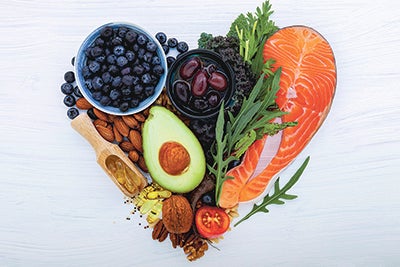Jena DeMoss: Heart-healthy foods to love
Published 6:30 am Wednesday, February 10, 2021
|
Getting your Trinity Audio player ready...
|
There’s been a popular, yet confusing, message being relayed over the past five years that there isn’t a causal relationship between eating saturated fats and heart disease. Scientist aren’t saying that saturated fat is good for you, but perhaps neutral for those that are healthy and active with no disease risk. If you have high cholesterol or high blood pressure or are at high risk for heart disease, you may want to take note of these two key points from the research:
If you replace saturated fats in your diet (examples: butter, cheese, coconut oil, palm oil) with unsaturated fats (examples: nuts, seeds, fatty fish like tuna and salmon, olive oil, avocados), you may reduce your risk of having a heart attack or stroke. (1)
If you replace the saturated fats in your diet with low-fiber, fast-digesting carbohydrates (examples: fruit juice, pop, candy, pasta, rice, energy bars), you’ll likely increase your risk for a heart attack or stroke. (1)
So don’t be deceived by this message being relayed that saturated fat is good for you; it’s still not “good” for you and when eaten in excess can increase your risk for heart disease leading to a heart attack or stroke. (1)
Here are three foods you could eat to show your heart some love:
Low-carb Vegetables – serving size is half cup cooked or one cup raw or two cups raw leafy greens. Examples: green beans, broccoli, spinach, kale, mushrooms, zucchini, yellow squash, Brussels sprouts. These veggies are loaded with vitamins, minerals and fiber and are low-calorie in comparison to other food groups.
Walnuts – serving size is one ounce or approximately seven walnuts. Walnuts are primarily a healthy fat source with some carbohydrate and a little bit of protein. They are high in vitamin B6, folate, thiamin – playing a role in cellular energy and a healthy nervous system.
Salmon/Tuna – salmon and tuna are both fatty fish and are excellent sources of omega-3 fatty acids, a polyunsaturated fat. Studies have found when participants replaced just 1 percent of their saturated fat intake with the same amount of calories coming from polyunsaturated fats, their risk of heart attack or stroke decreased by an average of 7 percent. The American Heart association considers 3.5 ounces of cooked fish or ¾ cup to be a single serving. For adults, two servings per week are recommended to help lower risk for heart disease.
This warm salad contains all three of these foods and is rated 5 stars! It’s a simple one-pan meal that is rich with heart-healthy ingredients.
Walnut-Crusted Salmon Winter Salad
Serves 4
All you need
• 12 oz. baby red or yellow potatoes, halved
• 12 oz. Hy-Vee Short Cuts sliced Brussels sprouts
• 1 tbsp plus 1/3 cup Gustare Vita olive oil, divided
• 1 large Honeycrisp or Gala apple, cored and cut into ½-inch-thick wedges
• 3 tbsp Gustare Vita balsamic vinegar
• 2 tbsp packed Hy-Vee brown sugar
• 1 tsp Hy-Vee Dijon mustard
• ⅛ tsp Hy-Vee salt
• 4 (5-oz.) pieces skinless fresh salmon fillets, ¾- to 1-inch-thick
• ¼ cup Hy-Vee chopped walnuts
• 6 oz. mixed salad greens
• ⅓ cup Hy-Vee Short Cuts chopped red onions
All you do
1. Preheat oven to 450 degrees.
2. Place potatoes and Brussels sprouts in a large bowl; toss with 1 tablespoon olive oil. Spread in a single layer on a 15×10-inch rimmed baking pan; add apple wedges. Roast for 10 minutes, stirring once halfway through.
3. Whisk together vinegar, brown sugar, mustard and salt in a small bowl. Slowly whisk in remaining 1/3 cup olive oil. Divide vinaigrette into two portions and set aside.
4. Push vegetables and apples to edge of pan, leaving them in a single layer. Pat salmon dry with paper towels; place in center of pan. Lightly brush salmon with one portion of vinaigrette; sprinkle with walnuts. Roast for 6 to 10 minutes or until salmon flakes with a fork (145 degrees) and vegetables and apples are tender. Drizzle with half of the remaining vinaigrette; sprinkle some of the greens around the salmon.
5. Place remaining salad greens on four salad plates; sprinkle with red onions. Arrange salmon, vegetables and apples on top. Drizzle with remaining vinaigrette.
Nutrition Facts per serving: 600 calories, 33g total fat, 4.5g saturated fat, 0g trans fat, 65mg cholesterol, 260mg sodium, 42g total carbohydrates, 5g dietary fiber, 19g total sugars, 7g added sugars, 36g protein. Daily Values: Vitamin D 80 percent, Calcium 8 percent, Iron 15 percent, Potassium 30 percent
Citations
1. Clifton PM, Keogh JB. A systematic review of the effect of dietary saturated and polyunsaturated fat on heart disease. Nutr Metab Cardiovasc Dis. 2017 Dec; 27(12):1060-1080. doi: 10.1016/j.numecd.2017.10.010. Epub 2017 Oct 18. PMID: 29174025. https://pubmed.ncbi.nlm.nih.gov/29174025/
The information is not intended as medical advice. Please consult a medical professional for individual advice.



